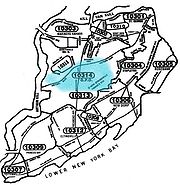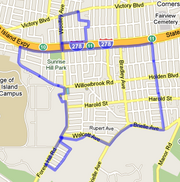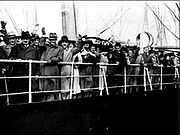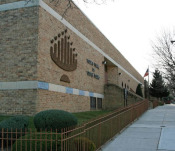From The Peopling of New York City
Contents |
Overview
The Staten Island Jewish community flourishes! Its arrival, early in the 1990s, set the stage for the large, growing community that it has become today. While ever expanding, Staten Island retains some of its Jewish pioneers, the first who settled here years ago. This beautiful blend of the old and new creates the harmonious Jewish community in Staten Island.
Demographics
Discovering the demographics of the Jewish population in Staten Island requires an in-depth analysis of a multi-faceted view of this ethnic group. To begin this journey, we plumb straight into the facts and figures of the Jewish population in Staten Island, in each of the boroughs, and in the general New York City. In addition to U.S. Census Bureau data, information is also available via the Mendel A. Berman Institute's North American Jewish Data Bank. The numbers resulting from this research are tabulated, and some facts are listed below.
Staten Island's Jewish community is one of the fasted growing in New York City. Between 1960 and 1981, the Jewish population mushroomed 200%, to 31,000. From 1991 to 2002, the borough’s Jewish households increased 40%. In 2002, people in Jewish households accounted for 12% of the borough’s total population, a 2% increase since 1991. Sixty five percent of the borough’s Jewish population is clustered in four zip codes located in Mid Staten Island, with the remaining population dispersed throughout the remaining zip codes.
Staten Island’s Jewish population is relatively young; only 8% of its population is 65 years old and above, and 59% of Jewish households consist of 2 parents and children. Most of the Orthodox settlement makes up the Willowbrook community, which has been steadily increasing in size over the years.
At first, the Jewish population resided in the lower/middle class economic level, with few incomes exceeding $75,000. Over time, however, the economic level rose so that average income is now higher than that of the general population. Only 9% of community members fall under 150% of the Federal Poverty Guidelines compared to the overall 16% of the Staten Island population, and only 18% earn less than $35,000 per year. The median income for a Jewish household is $34,000 compared to $21,000 for a non-Jewish household. The percentage of people 25+ years who hold at least a BA for the Jewish population is 49%, compared to 15% for the non-Jewish population.
In general, demographers have recorded an increase in the Jewish population since its inception in Staten Island. As the population grows, the community services have expanded to accommodate the increasing demands. The Jewish population, as well as the total population in Staten Island, is expected to continue growing, while continuing to contribute to the diversity of New York City.
| ' | ' | ' | ' | ' | ' | ' |
| Staten Island | Brooklyn | The Bronx | Manhattan | Queens | Total NYC | |
| % of NYC Population | .421% (33700/ 8008278) | 4.73% (379000/ 8008278) | 1.05% (83,700/ 8008278) | 3.93% (314500/ 8008278) | 2.98% (238,000/ 8008278) | 8008278 |
| Proportional Population Percentage | 7.8% (33700/ 433728) | 15.3% (379000/ 2465326) | 6.3% (83,700/ 1332650) | 20.5% (314500/ 1537195) | 10.7% (238,000/ 2229379) | 13.1% (1048900/ 8008278) |
| Difference in Proportional Population | N/A | -7.50% | -1.50% | -12.70% | -2.90% | |
| 1980 | 1991 | 2000 | 2002 | 2008 | Most recent data year (state year) | |
| Population | 30300 | 31000 | 33700 | 41600 | 44200 | |
| Pop. % of SI | 8.60% | 8% | 7.59% | 12% | 9.06% | |
| Most Dense Zip Code | 10314 Willowbrook | 10314 Willowbrook | 10314 Willowbrook | |||
| Largest Total Pop. Zip Code | 10314 Willowbrook | 10314 Willowbrook | 10314 Willowbrook | |||
| Pop. Change | 2700 | 10500 |
History
In the 1900s, most of the Jewish population resided in Europe. The Jews lived in small communities, simply and happily. There were some settlements in American and Israel, but the major waves of emigration from the Eastern hemisphere were yet to come. In general, the Jews clumped together when building communities, forming “shtetls” where one man was the water carrier, the other the blacksmith, the next the baker. Seldom did any lone Jewish man venture beyond his small town to settle in a neighborhood foreign to his religion. While there were Jewish settlements throughout Europe, the largest concentrations were in Germany, Poland, and Russia. Thus, the serene, content life of the Jews in middle Europe was brutally disrupted when WWII broke out. Nazi Germany rounded up the Jews, shipping them off in cattle carts to death camps. In the Soviet Union, even before WWII and especially with the rise of Stalin, the Jews faced religious intolerance and oppression. These two monumental events in history triggered significant streams of immigration to America and what would become Israel. (There were other events that served as push factors for the Jews that occurred before or during the same time, but these events were not written about as much as the Holocaust and Soviet Russia.) Many Jews set sail to America, hoping for a better life. However, it was life proved to be difficult in America as well.
Even after the Second World War, new struggles arose; jobs were scarce, religious life was slipping away, and anti-Semitism still existed. Dreams for a land with streets strewn with gold were quickly dashed as harsh reality set in. However, as disappointing and tough the new life in America turned out to be, it was usually much better than the one they left behind in Europe. Persecution and religious intolerance were the two biggest driving forces behind the Jewish emigration from Europe in the second half of the 20th century.
Most scholarship has focused on Jewish emigration from Europe, which has left out many other details and smaller historical events. A significant amount of Jewish emigration has come from the Middle East; persecution in Yemen and Iraq caused many Jewish families to leave behind everything, journey to America, and hope for the best. These small pieces of history seem to get lost in the broader scope of things and when dealing with larger events that involve more nations and have bigger repercussions. Also, historians seem to emphasizes why Jewish people left their homelands for America, while paying much less attention to why they chose to live specifically where they settled. This may have led to fuller view of the immigration experience, in terms of the newly populated communities of Jews in America.
The People
Mrs. Schwartz, a Holocaust Survivor, came to Staten Island five years ago to be closer to her married daughter when Mr. Schwartz passed away.
Rabbi Lehrfield came to Staten Island ten years ago to take on the position of Rabbi of the Young Israel of Staten Island. He has watched the community flourish under his guidance, and is proud to be a leader of the Jewish Community in Staten Island.
You can read what they say about Staten Island, their experiences of immigration and emigration, and how they ended up here on the Island in the Interview section.
Ethnic Stages
"Ethnic Stages" refers to the locations on Staten Island or within the community on which people display their community membership and identity. This can mean churches, community centers, specialized stores with products from the home country, restaurants that serve the community's cuisine, or other sorts of institutions.
The largest Jewish Orthodox community on Staten Island resides in Willowbrook. There are numerous institutions and locations on which people display their community membership and identity.
Synogogues:There are around eight synagogues, which service the large population dispersed throughout the 10314 zip-code area. The largest one, the Young Israel of Staten Island, boasts around 850 members. Services are conducted daily, throughout the year. In addition to religious services, the Young Israel also hosts numerous other activities, such as a summer day camp, weekend retreats, baseball leagues, and children's groups.
Jewish Community Center (JCC):
The JCC of Staten Island offers a large variety of activities aimed at both the Jewish and general communities. It has cultural effects on the Jewish community, provides important facilities, and promotes harmony in the whole community.
Schools:
There are two Jewish elementary schools (Merkaz HaTorah for Girls/Boys and Jewish Foundation School), as well as five preschool programs.
Kosher Stores:
While the Jewish population shops at many of the local Staten Island stores, they also frequent some local stores which are exclusively Jewish. The Kosher bakery, Dairy Palace (pizza store), and Glatt Kosher (butcher) offer the Jewish community in Staten Island Kosher food, which cannot necessarily be found in the regular Shoprite, King Kullen, or Stop'n'Shop foodstores.
Readings
Mozorov, Boris. title. *where published?*: Taylor & Francis, Inc., 1999.
Ro'i, Yaakov. The Struggle for Soviet Jewish Emigration, 1948-1967. Cambridge UK: Cambridge University Press, 2003.
Aharoni, Reuben. Jewish Emigration from the Yemen, 1951-98: Carpet Without Magic. Richmond UK: Curzon Press, 2001.
Shrayer, Maxim D. Waiting For America. Syracuse NY: Syracuse University Press, 2007.
Gat, Moshe. The Jewish Exodus from Iraq, 1948-1951. Portland OR: Frank Cass & Co. Ltd., 1997.
Hoffman, Betty T. Jewish Hearts: A Study of Dynamic Ethnicity in the United States & the Soviet Union. *where published?*: State University of New York Press, 2001.
Barkai, Avraham. Branching Out: German-Jewish Immigration to the United States 1820-1914. *where published?*: Holmes & Meier Publishers, 2005.
Kessner, Thomas. The Golden Door: Italian and Jewish Immigrant Mobility in New York City, 1880-1915. New York: Oxford UP, 1977.
Tango, Jenny. The Jewish Community of Staten Island. Charleston, SC: Arcadia Publishing, 2004.
Further Research
Relevant LOC Subject Headings:
• Jews -- United States -- History. • Jews -- Migrations -- History. • United States -- Emigration and immigration. • Europe -- Emigration and immigration. • Immigrants -- United States -- History. • United States -- Ethnic relations. • Jews -- Germany -- History -- 1933-1945. • Jews -- Migrations. • Germany -- Emigration and immigration -- History. • Jews -- United States -- Identity. • Jews -- Cultural assimilation -- United States. • Americanization. • Emigration and immigration -- Psychological aspects. • Jews -- Soviet Union -- Migration • Jews -- Persecutions -- Soviet Union -- Public opinion. • Ukraine -- Emigration and immigration -- History -- Sources. • Jews -- Government policy -- Ukraine -- Sources. • Jews -- Government policy -- Soviet Union -- Sources. • Jews -- Ukraine -- History -- 20th century -- Sources. • Jews -- Ukraine -- Social conditions -- 20th century -- Sources. • Jews -- Ukraine -- Migrations -- History -- Sources. • Ukraine -- Emigration and immigration -- History -- Sources. • Ukraine -- Ethnic relations -- History -- 20th century -- Sources.
Relevant Keywords:
• Immigration • Emigration • Jews • Jewry • Jewish • Persecution • Exodus • New York • America • Sefardik • Sefardim • Ashkenazic • Ashkenazim • Identity • Orthodox • Ethnic • Ethnicity • Suffering • Holocaust • Germany • Russia • Poland





